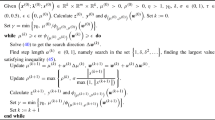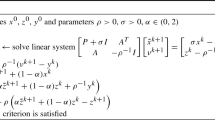Abstract
This manuscript presents a new heuristic algorithm to find near optimal integer solutions for the singly constrained assignment problem. The method is based on Lagrangian duality theory and involves solving a series of pure assignment problems. The software implementation of this heuristic, ASSIGN+1, successfully solved problems having one-half million binary variables (assignment arcs) in less than 17 minutes of wall clock time on a Sequent Symmetry S81 using a single processor. In computational comparisons with MPSX and OSL on an IBM 3081D, the specialized software was from 100 to 1,000 times faster. In computational comparisons with the specialized code of Mazzola and Neebe, we found that ASSIGN+1 was 40 times faster. In computational comparisons with our best alternating path specialized code, we found that ASSIGN+1 was more than three times faster than that code. This new software proved to be very robust as well as fast. The robustness is due to an elaborate scheme used to update the Lagrangean multipliers and the speed is due to the fine code used to solve the pure assignment problems. We also present a modification of the algorithm for the case in which the number of jobs exceeds the number of men along with an empirical analysis of the modified software.
Similar content being viewed by others
References
V. Aggarwal, “A Lagrangian-relaxation method for the constrained assignment problem,”Comput. Oper. Res. vol. 12 pp. 97–106, 1985.
E. Allen, R. Helgason, J. Kennington, and B. Shetty, “A generalization of Polyak's convergence result for subgradient optimization,”Math. Prog. vol. 13, pp. 309–318 1987.
M. Ball, U. Derigs, C. Hibrand, and A. Metz, “Matching problems with generalized upper bound side constraints,”Networks vol. 20 pp. 703–721, 1990.
R. Barr, F. Glover, and D. Klingman, “The alternating basis algorithm for the assignment problems,”Math. Prog., vol 13 pp. 1–13, 1977.
R. Barr, K. Farhangian, and J. Kennington, “Networks with side constraints: An LU factorization update,”Ann. Society of Log. Eng. vol. 1 pp. 66–85, 1986.
J. Brans, M. Leclercq, and P. Hansen, “An algorithm for optimal reloading of pressurized water reactors,” inOperational Research'72, M. Ross, Ed., North Holland Publishing Co. Amsterdam, 1973, pp. 417–428.
N. Bryson, “Parametric programming and Lagrangian relaxation: The case of the network problem with a single side-constraint,”Comput. Oper. Res. vol. 18 pp. 129–140, 1991.
H. Everett, “Generalized Lagrange multiplier method for solving problems of optimum allocation of resources,”Oper. Res. vol. 11 pp. 399–417, 1963.
S. Gass and T. Saaty, “The computational algorithm for the parametric objective function,”Nav. Res. Log. Q. vol. 2 pp. 39–45, 1955.
A. Geoffrion, “An improved implicit enumeration approach for integer programming,”Oper. Res. vol. 17 pp. 437–454 1969.
A. Geoffrion, “Lagrangian relaxation for integer programming,”Math. Prog. vol 2 pp. 82–114, 1974.
F. Glover, “A multiphase-dual algorithm for the zero-one integer programming,”Oper. Res. vol. 13 pp. 879–919, 1965.
F. Glover, D. Karney, D. Klingman, and R. Russell, “Solving singly constrained transshipment problems,”Transp. Sci. vol. 12 pp. 277–297, 1978.
A. Gupta and J. Sharma, “Tree search method for optimal core management of pressurised water reactors,”Comput. Oper. Res. vol. 8 pp. 263–269, 1981.
J. Kennington and F. Mohammadi, “The singly constrained assignment problem: An AP basis approach,” Technical Report 93-CSE-25, Department of Computer Science and Engineering, Southern Methodist University, Dallas, TX, 1993.
J. Kennington and Z. Wang, “An empirical analysis of the dense assignment problem: Sequential and parallel implementations,”ORSA J. Comput. vol. 3 pp. 299–306, 1991.
J. Kennington and Z. Wang, “SEMI users guide,” Technical Report 90-CSE-20, Department of Computer Science and Engineering, Southern Methodist University, Dallas, TX, 1990.
J. Kennington, and Z. Wang, “A shortest augmenting path algorithm for the semi-assignment problem,”Oper. Res. vol. 40 pp. 178–187, 1992.
J. Kennington and A. Whisman, “Netside users guide,” Technical Report 90-CSE-37, Department of Computer Science and Engineering, Southern Methodist University, Dallas, TX, 1990.
D. Klingman and R. Russell, “Solving constrained transportation problems,”Oper. Res. vol. 23 pp. 91–106, 1975.
D. Klingman and R. Russell, “A stream lined approach to the singly constrained transportation problem,”Nav. Res. Log. Q. vol. 25 pp. 681–695, 1978.
“Mathematical Programming System Extended, Mixed Integer Programming/370 Program Reference Manual,” SH19-1099-1, IBM, White Plains, NY, 1979.
J. Mazzola and A. Neebe, “Resource constrained assignment scheduling,”Oper. Res. vol. 34 pp. 560–572, 1986.
G. Nemhauser and L. Wolesy,Integer and Combinatorial Optimization, John Wiley and Sons: New York, NY, 1988.
Optimization Subroutine Library: Guide and Reference, SC23-0519-1, IBM, Kingston, NY, 1990.
R. Parker and R. Rardin,Discrete Optimization, Academic Press Inc.: New York, NY, 1988.
C. Ryu and M. Guignard, “Lagrangian approximation techniques for the simple plant location problem with an aggregate capacity constraint,” Working Paper 91-06-06, Department of Decision Sciences, The Wharton School, University of Pennsylvania, Philadelphia, PA, 1991.
H. Salkin,Integer Programming, Addison-Wesley Publishing Co. Reading, MA, 1974.
J. Shapiro, “Generalized Lagrange multipliers in integer programming,”Oper. Res. vol. 19 pp. 68–76, 1971.
J. Shapiro, “A survey of Lagrangian techniques for discrete optimization,”Ann. Discrete Math. vol. 5 pp. 113–138, 1979.
G. Yu, “Algorithms for optimizing piecewise linear functions and for degree constrained minimum spanning tree problems,” Department of Decision Sciences, The Wharton School, University of Pennsylvania, Philadelphia, PA, 1991.
Author information
Authors and Affiliations
Rights and permissions
About this article
Cite this article
Kennington, J.L., Mohammadi, F. The singly constrained assignment problem: A Lagrangian relaxation heuristic algorithm. Comput Optim Applic 3, 7–26 (1994). https://doi.org/10.1007/BF01299389
Received:
Revised:
Issue Date:
DOI: https://doi.org/10.1007/BF01299389




